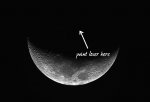Hello,
I was wondering, how many mW of a red laser (less scattering through the atmosphere) would be required for the dot of it to be seen with a telescope on the surface of the moon? I know it sounds a little bit crazy, but if you could adjust the divergence of your beam so as to stay tight for such a great distance, and maybe pointing on the dark side of the moon, you would be able to see something with a very powerful telescope!
I was wondering, how many mW of a red laser (less scattering through the atmosphere) would be required for the dot of it to be seen with a telescope on the surface of the moon? I know it sounds a little bit crazy, but if you could adjust the divergence of your beam so as to stay tight for such a great distance, and maybe pointing on the dark side of the moon, you would be able to see something with a very powerful telescope!







